While Windows 7 is not a new operating system anymore, many choose to stick with it because they are either so comfortable with it that they don’t want to change their operating system or reluctant to learn the ways of a new operating system.
Like newer Windows versions, Windows 7, too, has its share of problems. For instance, sometimes the updates stall for no good reason.
Microsoft regularly releases updates to fix issues with and improve performance of its operating system. However, when the feature that is supposed to resolve issues and better performance starts giving problem, it can be rather frustrating.
That said, you don’t need to worry about the Windows 7 updates not downloading issue because in this post we have provided several solutions to it.
Start with the first troubleshooting step and move to the next one and so on until you’re able to fix the issue. We also recommend you to leave us a comment telling us which of these solutions worked for you.
However, before we look at the solutions, let’s learn a bit more about this error.
The Error Message
A very useful feature, Windows Update can prove problematic sometimes. Windows 7 users have frequently complained about not able to download Windows Update.
What happens is the Update feature simply stands still at 0% while the download process is on and refuses to move any further.
You’re likely to encounter the following error message when this happens.

There are several ways to fix this issue. In this post, we’ve discussed the following six solutions:
- Run Troubleshooter
- Download Windows updates manually
- Reset Windows Update Service
- Update Windows Update Agent
- Turn off Windows Firewall
- Do a Clean Boot
Solution #1 – Run Troubleshooter
Did you know that Windows 7 come with an inbuilt troubleshooter which can assist you in fixing issues on your Windows system?
This tool can assist you in fixing this issue, too.
To use the inbuilt troubleshooter, perform these steps:
- Click the Windows icon in your taskbar, type “troubleshoot” in start search box and then press Enter
- Scroll down the window until you see System and Security Click Fix problems with Windows Update (the first entry below the heading)
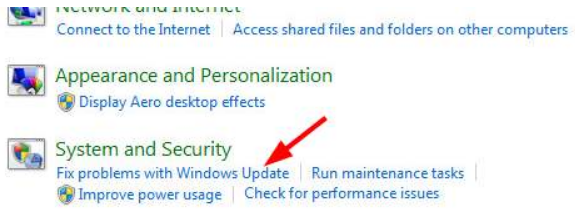
- A Windows Update window will appear on your screen. Press the Next Windows will try to detect the problem. Just follow the onscreen instructions to resolve the issue.
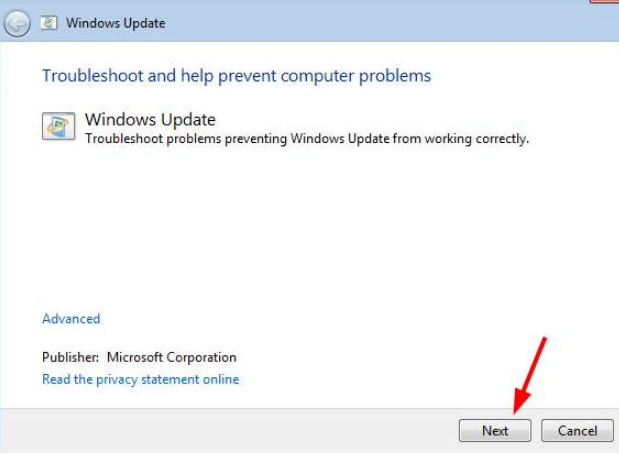
Solution #2 – Download Windows Update Manually
You can choose to download the updates manually if the Windows Update feature is not working. Of course, the manual procedure is a little time-consuming but thankfully not much technical.
As it is important to keep your download and install at least the important updates to keep your Windows 7 safe and healthy, you are recommended to update the system manually when the automatic option is not working.
Here are the steps you need to perform.
- Click the Windows icon in the taskbar
- In the Start Search bar type “Windows update” and then press Enter
- Click updates available
- Now all the available updates will appear on your screen
- Just note the code of the update that you wish to download (Update codes start with “KB”)
- Now click this link to go to Windows Download Center, click on the search icon (magnifying glass) on your right hand side, and type the noted update code in the search box and press Enter
- Locate Downloads category, and then under this category, select the result that you want to download
- Finally click Download
- Once you’ve downloaded the required update, browse to its location and double-click the update to install it
- Follow the instructions on your screen to install this update
In this way, you can choose to install all relevant system updates. Of course, the method is time-consuming, but that’s not too high a price to pay to keep your system in top health when automatic update feature is not working.
Solution #3 – Reset Windows Update Service
An important system service, Windows Update service allows you to use the Windows Update feature. Resetting Windows Update service can help fix issues problems with Windows Update feature.
This solution has worked for many users who found themselves up against this irritating problem, and it may work for you as well. As this solution is a fairly easy one, it’s definitely worth a shot.
- Click the Windows icon on your taskbar, type “run” in the search box and press Enter.
- In the run dialog box, write “services.msc”. Now press Enter or the OK button.
- The Services window will open on your screen. All the services are listed under the Name column. Browse through the list to locate Windows Update. Right-click it and then click Restart.
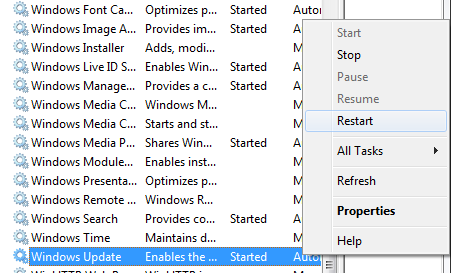
- The Windows Update service will restart now. This will not take more than a couple of seconds.
Solution #4 – Update Windows Update Agent
Windows Update Agent (its short form is WUA) is an important agent program which works along with Windows Server Update Service to download important updates automatically from Microsoft.
If you’re struggling with the aforementioned problem, you may find Microsoft Windows Update Agent useful.
Go to the Microsoft website to download and install it. Once you’ve have it on your system, update it to see if it resolves the issue.
Note – You will need to have Service Pack 1 installed on your computer before you update the Windows Update agent. For more information on how to update the Windows Update, refer this Microsoft support page.
To install Service Pack 1, follow these steps:
- Log on to this Microsoft Support Page
- Scroll down to the Manually download the Windows Update Agent from the Microsoft Download Center section
- Select the second option, Stand-alone packages for Windows 7 SP1 and Windows Server 2008 R2 SP1 to see all installation packages under it.
- Choose and download the package that’s appropriate for your Windows 7 system
- Browse to the location where you’ve saved this file and double-click it for installing it
- Follow the instructions on your screen to complete installation
- Once the installation is complete, reboot your pc
Check if the issue is resolved. If not, go to the next solution.
Solution #5 – Turn off Windows Firewall
Many Windows users have reported the cause of error in their case was none other than Windows Firewall, and they were able to fix the issue by disabling it.
Note: After you’ve installed the latest Windows Update, you should turn on the firewall to ensure your pc or laptop remains safe from malware and hackers.
- Click the Windows icon in the taskbar, type control panel in the start search box and then press Enter
- Scroll down until you see Windows Firewall
- Click it
- Click Turn Windows Firewall on or off (in the left-hand side pane)
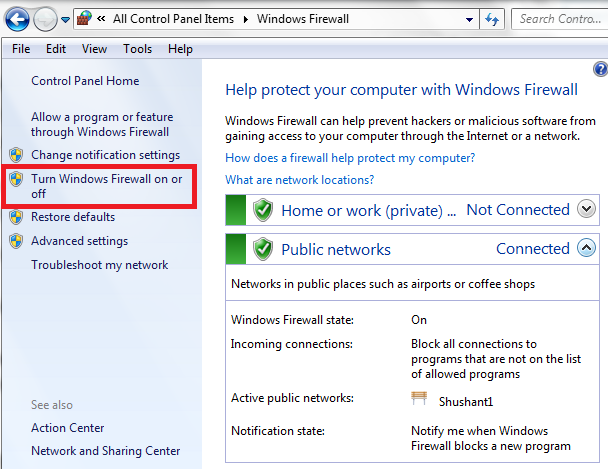
- Select Turn off Windows Firewall (not recommended)
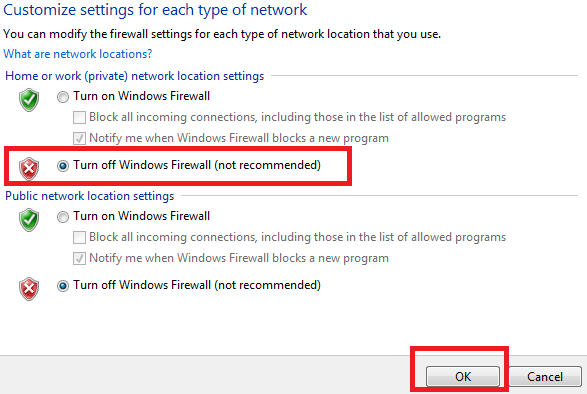
- Click OK
Solution #6 – Clean Boot
If nothing else works for you, a clean boot might help.
In Clean boot, the Windows starts with only the bare minimum startup programs and drivers. With this method, you can locate the application that’s causing this error.
- Click the Windows icon in the taskbar, type run and press Enter
- In the run dialog box, write msconfig and press OK
- Click the General tab (the first one)
- By default, Normal startup option is selected. What you need to do is choose Selected startup (the third option) and under it deselct the second option, Load startup items

- Now click the Services tab
- Select Hide all Microsoft services (located at the bottom left-hand corner)
- Now click Disable all
Note – It is important that you first hide Microsoft Services (by ticking the box next to it) and click Disable all. Otherwise, certain secure services might get disabled, which in turn might lead to unexpectedly serious consequences.
- Click Apply and then OK
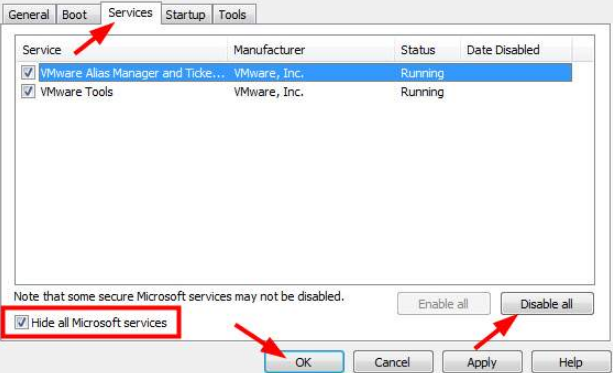
- Reboot Windows
Now see if you’re able to download Windows updates. In case you’re able to, click the Services tab in the System Configuration window and enable the listed services one at a time. This will help you locate the culprit application.
Once you’ve identified the culprit application, you can choose to either uninstall it or disable it. If you need that application, in its place use another alternative.
After you’ve solved the problem, revert to original settings.

Leave a Reply